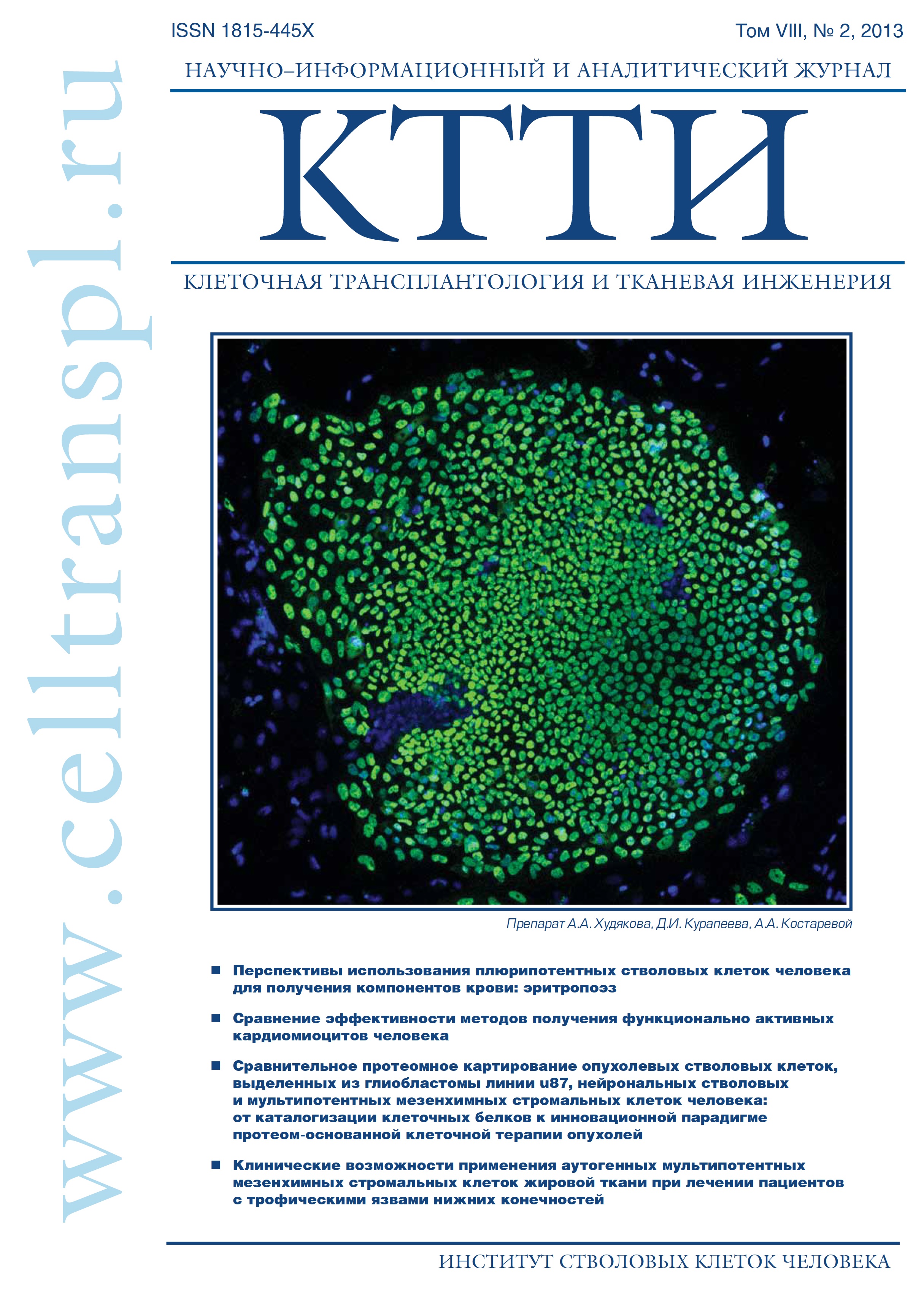Algorithm activity of the Stem Cells Bank-Register in Moscow
- Authors: Kobzeva I.V1, Astrelina T.A1, Yakovleva M.V1, Karpova E.E1, Kruglova Y.A1, Lebedeva L.L1, Puhlikova T.V1, Chumak A.A1, Stavcev D.S1, Gomzyakov A.E1, Boyakova E.V1
-
Affiliations:
- Moscow Stem Cell Bank, Moscow
- Issue: Vol 8, No 2 (2013)
- Pages: 69-74
- Section: Articles
- URL: https://genescells.ru/2313-1829/article/view/121616
- DOI: https://doi.org/10.23868/gc121616
- ID: 121616
Cite item
Abstract
Full Text
About the authors
I. V Kobzeva
Moscow Stem Cell Bank, Moscow
T. A Astrelina
Moscow Stem Cell Bank, Moscow
M. V Yakovleva
Moscow Stem Cell Bank, Moscow
E. E Karpova
Moscow Stem Cell Bank, Moscow
Y. A Kruglova
Moscow Stem Cell Bank, Moscow
L. L Lebedeva
Moscow Stem Cell Bank, Moscow
T. V Puhlikova
Moscow Stem Cell Bank, Moscow
A. A Chumak
Moscow Stem Cell Bank, Moscow
D. S Stavcev
Moscow Stem Cell Bank, Moscow
A. E Gomzyakov
Moscow Stem Cell Bank, Moscow
E. V Boyakova
Moscow Stem Cell Bank, Moscow
References
- Gluckman E., Broxmeyer H.A., Auerbach A.D. et al. Hematopoietic reconstitution in a patient with Fanconi's anemia by means of umbilical-cord blood from an HLA-identical sibling. New Engl. J. Med. 1989; 321(17): 1174-78.
- Glukman E. Ten years of cord blood transplantation: from bench to bedside. British J. Hematol. 2009; 147: 192-9.
- Gluckman E. Milestones in umbilical cord blood transplantation. Blood Reviews 2011; 25(6): 255-9. доноров ГСК ПК в базе данных регистра позволяет подобрать совместимую (6/6) пару донор-реципиент с частотой вероятности 1:151. Предложенный алгоритм работы Московского банка-регистра безвозмездных неродственных доноров ГСК ПК рекомендуется использовать при создании, усовершенствовании и работе других банков-регистров безвозмездных неродственных доноров ГСК ПК.
- Rubinstein P. Why cord blood? Hum. Immunol. 2006; 67: 398-404.
- Rocha V., Broxmeyer H.E. New approaches for improving engraftment after cord blood transplantation. Biol. Blood Marrow Transplant. 2010; 16; S126-32.
- Broxmeyer H.E. Umbilical cord transplantation: epilogue. Semin. Hematol. 2010; 47(1): 97-103.
- Welte K., Foeken L., Gluckman E. et al. International exchange of cord blood units: the registry aspects. Bone Marrow Transpl. 2010; 45: 825-31.
- Lauber S., Latta M., Kluter H. et al. The Mannheim cord blood bank: experiences and perspectives for the future. Transfus. Med. Hemother. 2010; 37: 90-7.
- Rubinstein P. Cord blood banking for clinical transplantation. Bone Marrow Transpl. 2009; 44: 635-42.
- Navarrete C., Warwick R., Armitage S. et al. The London Cord Blood Bank. Bone Marrow Transpl. 1998; 22(1): 6-7.
- http://www.bmdw.org
- Wagner J.E., Gluckman E. Umbilical cord blood transplantation: the first 20 years. Semin. Hematol. 2010; 47(1): 3-12.
- Gluckman E. Milestones in umbilical cord blood transplantation. Blood Reviews 2011; 25(6): 255-9.
- http://www.netcord.org
- Navarrete C., Contreras M. Cord blood banking. A historical perspective. Br. J. Haematol. 2009; 147: 236-45.
- Armitage S., Warwick R., Fehily D. et al. Cord blood bankingin London: the first 1000 collections. Bone Marrow Transpl. 1999; 24: 139-45.
- Davey S., Armitage S., Rocha V. et al. The London cord blood bank: analysis of banking and transplantation outcome. British J. Haematol. 2004; 125: 358-65.
- Brown J., Poles A., Brown C.J. et al. HLA-A, -B and -DR antigen frequencies of the London Cord Blood Bank units differ from those found in established bone marrow donor registries. Bone Marrow Transpl. 2000; 25: 475-81.
- Bray R.A., Hurley C.K., Kamani N.R. et al. National marrow donor program HLA matching guidelines for unrelated adult donor hematopoietic cell transplants. Biol. Blood Marrow Transpl. 2008; 14: 45-53.
- Rocha V., Broxmeyer H.E. New approaches for improving engraftment after cord blood transplantation. Biol. Blood Marrow Transpl. 2010; 16: S126-32.
- Иоффе Ю.Г. Современное состояние донорства гемопоэти-ческих стволовых клеток в России. Клиническая онкогематология 2008; 4(1): 344-6.
- Haimila K., Penttila A., Arvola A. et al. Analysis of the adequate size of a cord blood bank and comparison of HLA haplotype distributions between four populations. Hum. Immunol. 2013; 74(2): 189-95.
Supplementary files










